Francesca and Henk-Jan's Backpacking Trip!
Tuesday, August 10, 2010
Lhasa Yogurt
Sadly we had to leave Chengdu on the morning of August the 9th (we could have stayed there way longer, turns out there is a LOT to do there!) for our flight into Lhasa. While the first activity we’d be doing, the Tibetan Shoton (aka the Yogurt Banquet) Festival wasn’t until the 10th, we knew we would need at least a day to lay back and acclimatize our lack-of-oxygen headaches away. We boarded the plane after having breakfast of KFC (where we were then served even more breakfast onboard!) and sat back to wait for our journey to the roof of the world. Before we landed, I looked out the window and my eyes were amazed! The scenery looked absolutely incredible! Unlike anything we had seen on our travels through Asia… it actually looked closest to New Zealand with the extremely varied landscape. The first thing I thought is that Tibet looks outer-worldly, almost like the barren but beautiful scenery of a foreign planet. I started snapping photos, not wanting to let the opportunity to get a few shots from the air go by. Check them out!

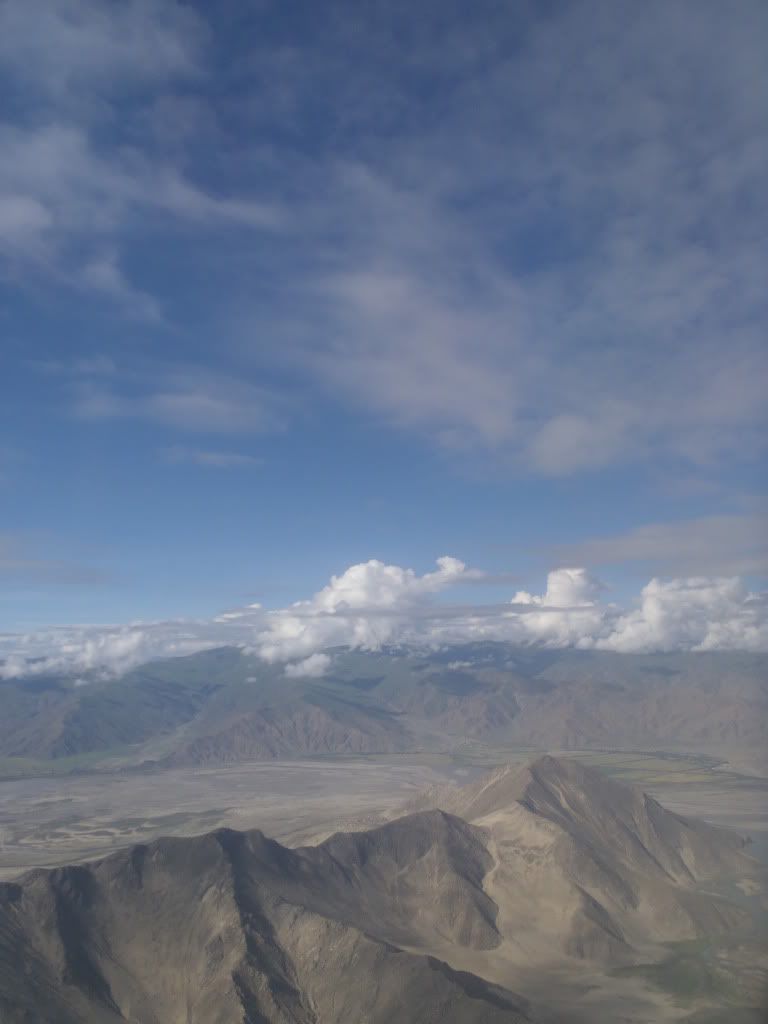

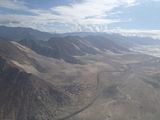
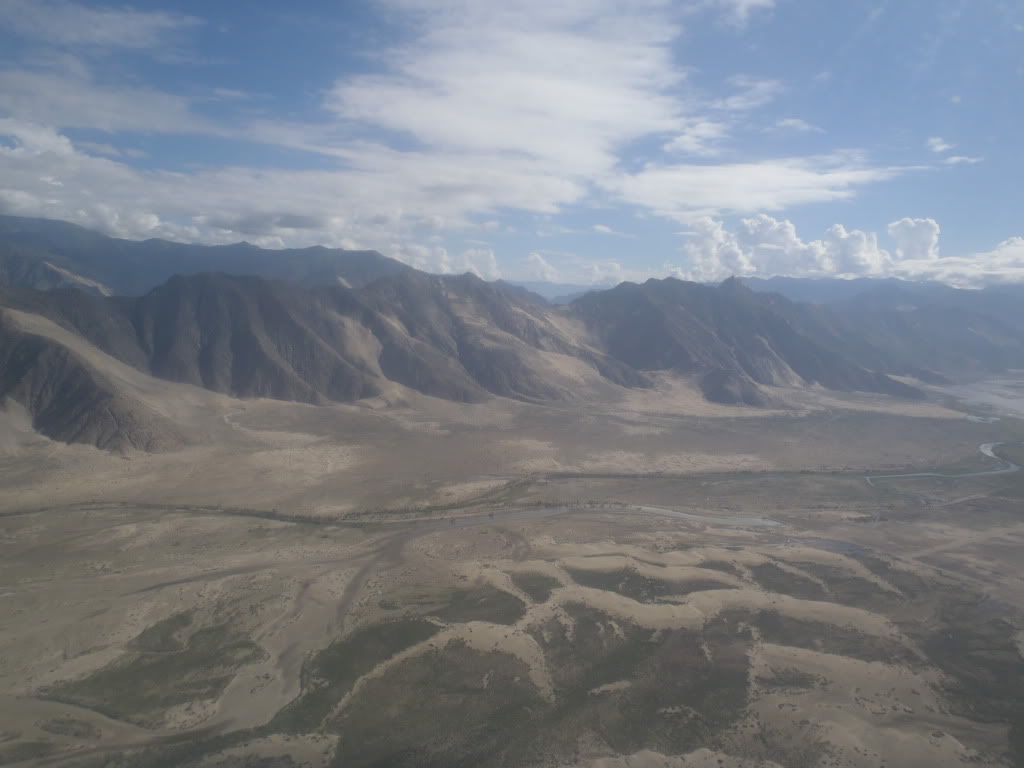
Before we even got off the plane I noticed the change in oxygen levels – it was definitely a bit harder to breathe. Henk and I waited for our bags and then journeyed outside to meet our tour guide and driver for the next 2.5 weeks. Ray (Yes, that’s a code-name!) met us and immediately tossed a long, white scarf around each of our necks, then took our bags and led us to the car. These scarves, we later learned, are called ‘khatags’ and are used to designate a person (or a deity, image, etc.) of great importance which originated with the Tibetan tradition of adorning deities with clothing to show the god’s magnitude. We noticed later at the Shoton Festival that these scarves were being thrown at the giant Buddha image! (But more about that later.)
The drive to Lhasa, while a couple of hours long, was so scenic that we didn’t really notice the time! Vast open areas with water streaming through, bright blue sky as far as you could see in any direction. Plus that blue sky is an amazing contrast to the browner, barren-looking earth. There were fields filled with bound stacks of barley, which we’d later learn is the staple crop of the Tibetan people. We passed huge mountains with ladders drawn on in what looked like white chalk. Those ladders are drawn there by religious pilgrims who believe the area is sacred and wish to express this by making sure the god(s) has a way to get down from the heaven to earth should they need to make a visit. Henk and I also questioned our guide about the animal skulls we kept seeing mounted on top of doorway entrances. He explained to us that these were YAK bones! We were really excited to catch our first glimpse of a yak, though it wouldn’t be that day.
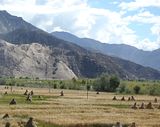
Upon arriving in Lhasa we immediately noticed a few key things about the city – many signs were written in both Tibetan and Chinese, but in some places, the signs were only written in Chinese. It was explained that Chinese is the language taught to Tibetans in school (while Tibetan is always spoken at home) and thus Tibetan was being replaced as the ‘masses’ language’ by Chinese. This is being perpetuated by the huge immigration of Han Chinese into Tibet. They have been described as absolutely ‘pouring-in’ post the infamous train to Tibet being completed. In fact, I later read that in the city of Lhasa, Han Chinese outnumber Tibetans with a ratio of 2:1.
The Chinese are given mass incentives by their government to move into the Tibet Autonomous Region (TAR), as the government believes the immigration will ‘aid in the ‘assimilation’ of Tibetan people. Chinese thus are ever-present in Lhasa as the owners of the majority of companies, guesthouses, restaurants, tour agencies, and even souvenir stalls lining the streets. While all workers seen on the construction sites of roads and temples, those cleaning hotels or working as waitresses/waiters, and even those guiding Westerners around Tibet are indeed Tibetans, their bosses are almost always Han Chinese. Likewise, Chinese police are absolutely everywhere. They sit on top of roofs with their rifles posed and their binoculars scanning the city, they march in the streets in unison, and they are even working undercover in monasteries (which have been the main arena of protest against China’s presence in Tibet) or other areas as spies.
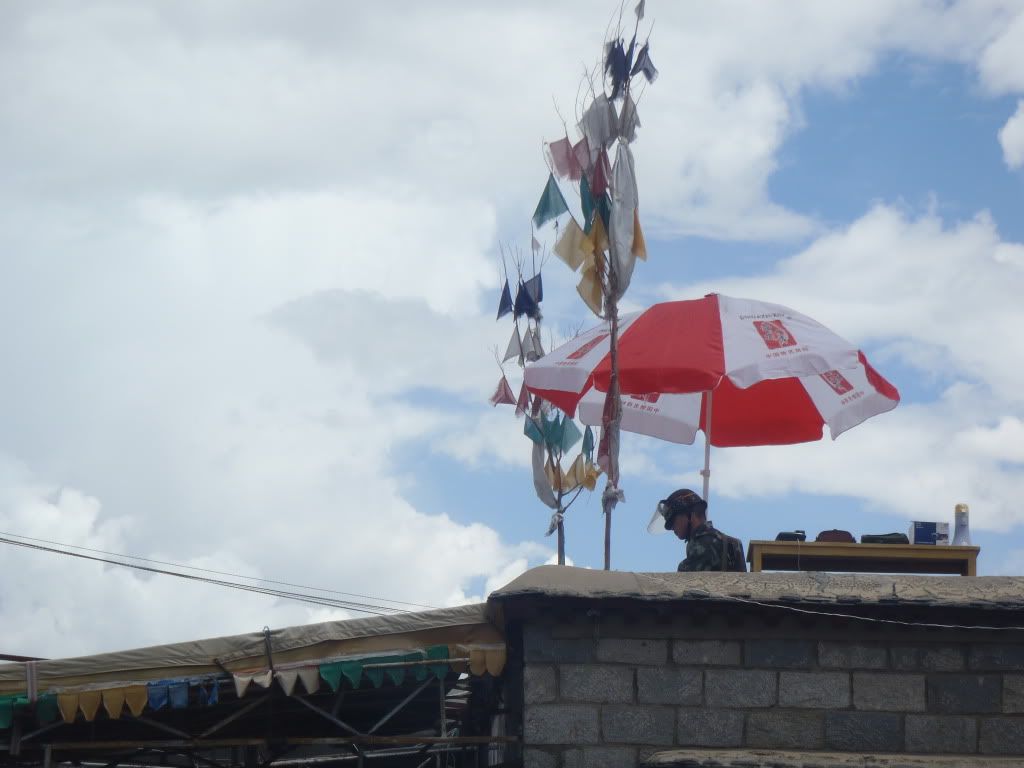
Putting aside the Han Chinese and focusing on the Tibetans themselves, the first thing we noticed about the Tibetan people once we stepped foot into Lhasa is how different and decent-looking they are! Not only were they much more attractive than most of the other people we encountered on our trip (and surely much better looking than the Han Chinese) but they were also dressed extremely sharp. All of them had a bit of permanent rosy-cheek, I guess from living in such a dry climate so close to the sun. Strangely enough, it was actually a little like permanent make-up and gave them a unique-look that wasn’t half-bad, even helped to draw more attention to their eyes.
The men wore crisp-looking jackets and cowboy-esque hats; the women all had their hair neatly braided with colorful strings pinned up and wrapped around their heads and donned long striped skirts. Some of the Tibetan men, known as Khampas, had fake pieces of black string, made to look like hair, attached to their own with a stylish clip. Even those who didn’t look very traditional, the children and some of the younger adults, wore snazzy-looking fake but sharp-looking designer jeans, jackets, and caps. And every outfit was finished off with large amounts of fake coral, turquoise, or Buddha’s eye jewelry. Wow, who would have ever predicted that Tibet would actually look fashion-forward!
A little explanation from the Wiki about the origin of Tibetan people:
Tibetans traditionally explain their own origins as rooted in the marriage of the monkey Pha Trelgen Changchup Sempa and rock ogress Ma Drag Sinmo.[18] Tibetans who display compassion, moderation, intelligence, and wisdom are said to take after their fathers, while Tibetans who are "red-faced, fond of sinful pursuits, and very stubborn" are said to take after their mothers.
Ray had found us a hostel in Lhasa that was in our price-range and thankfully turned out to be pretty decent. It was called the Rama Kharpo (the White Goat) and accordingly had a large painted image of a goat behind its front desk. We learned that it was an ancient belief that the area where the Jokhang Temple is located now in Lhasa originally had a lake on it and goats were used to help fill the area with sand and construct the temple. Since they worked hard on this, they have a bit of a special place in Tibetan’s hearts, which is how our guesthouse got its name honoring them! Since our room wasn’t quite ready yet, we dropped off our bags and took a walk through the city.

What we saw was really breath-taking: there were pilgrims everywhere displaying their religious dedication. Full-body prostration was done not only at the walls of the temples, but even just in the middle of the street! Worshippers had special wooden blocks they used to protect their hands when they did what basically looked like a ‘Slip ‘N’ Slide’ onto the hard pavement ended up with their bellies to the floor. Then they would get up and repeated the process… as many times as they could muster! The more times you repeat something (saying a mantra, spinning a prayer-wheel, prostrating yourself before the divine) in Tibet, the more effective the result will be.
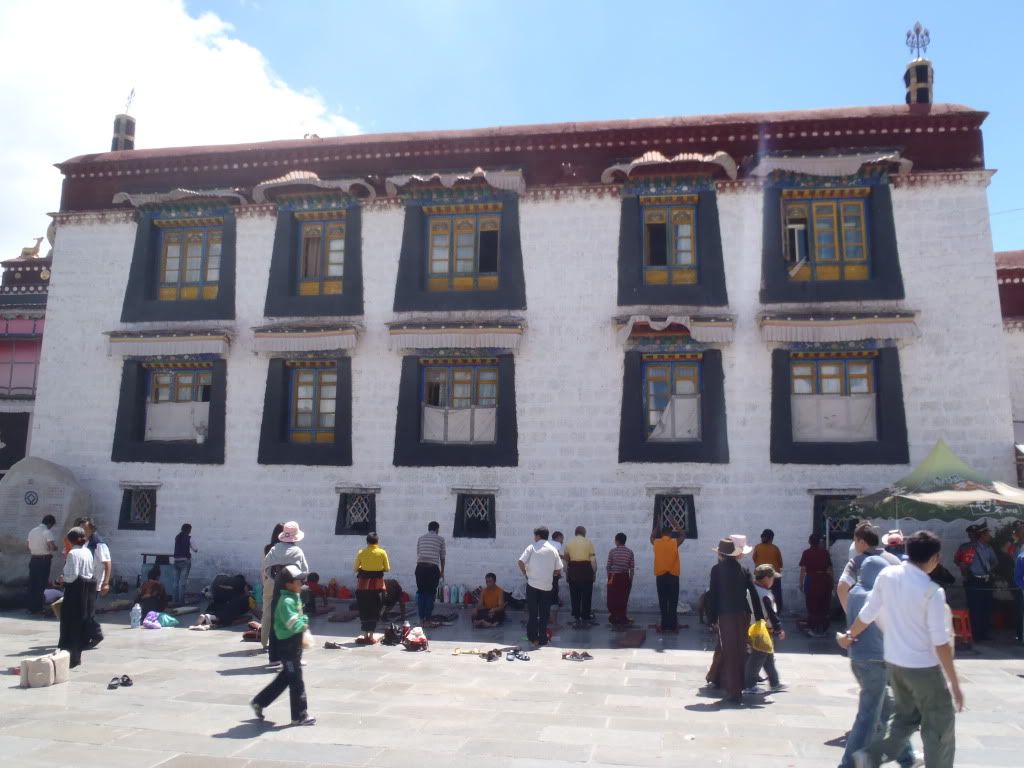
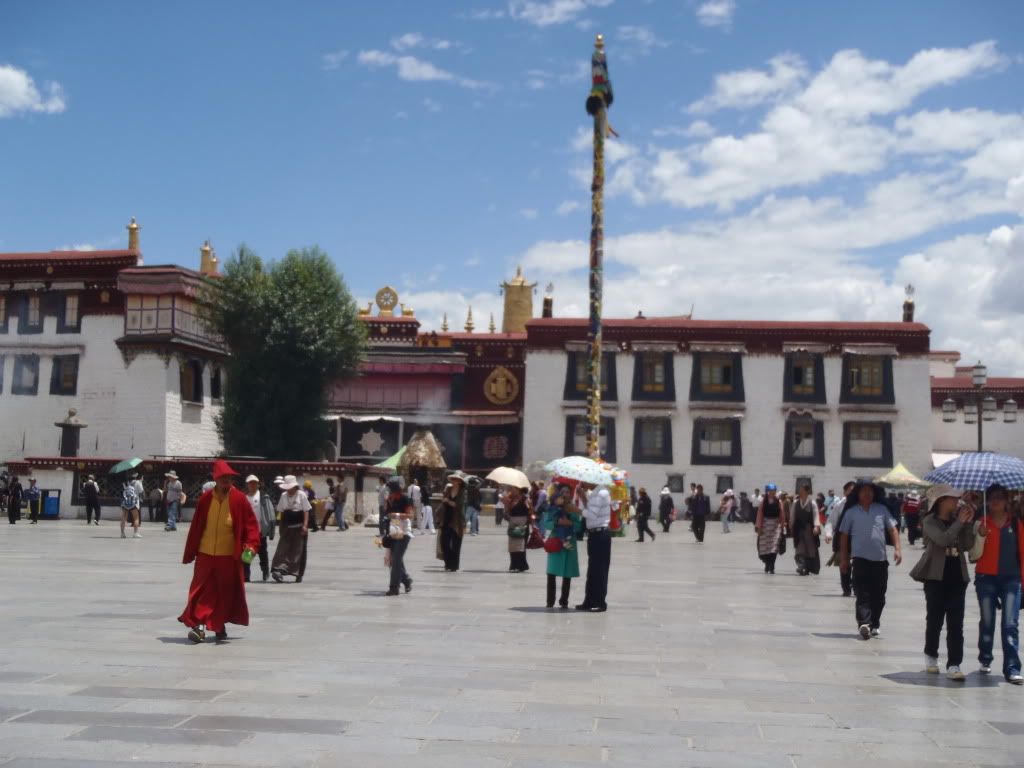
We arrived at New Mandala Restaurant ready to partake in some Tibetan food: yak momos! These little delicious things were balls of yak meat wrapped up in a ‘dumpling-like’ casing. They came with a slightly spicy dipping sauce to dip the suckers in. Shockingly (despite the insanely slow service at the restaurant) yak was quite tasty!! It was surprisingly juicy and flavorful for such a healthy, lean animal. Unlike cattle, the fat in yak doesn’t ‘marble’ inside the meat but ends up as a separate layer one can just ‘pull-off’ of the animal when butchering. This results in yak being 90+ % fat free, but apparently it also doesn’t affect the taste of the animal! We chatted with Ray about some of his recent guiding experiences while consuming our first Tibetan dish. Once we returned, our room was ready and we were ready to crash. But not sleep! While the altitude was getting to us, Ray warned us to not sleep now, otherwise we won’t be able to later. (He also gave us more things we couldn’t do yet because of the risk of AMS – take a shower, have any yak-butter tea, etc.) Henk and I tried to rest up watching some Chinese movies (I think ‘Raise the Red Lantern’ and later Henk ventured out to an Indian place ‘Lhasa Namaste’ to bring us back (sadly) some less-than-average Indian food. Didn’t matter… the next morning we had a festival to attend!
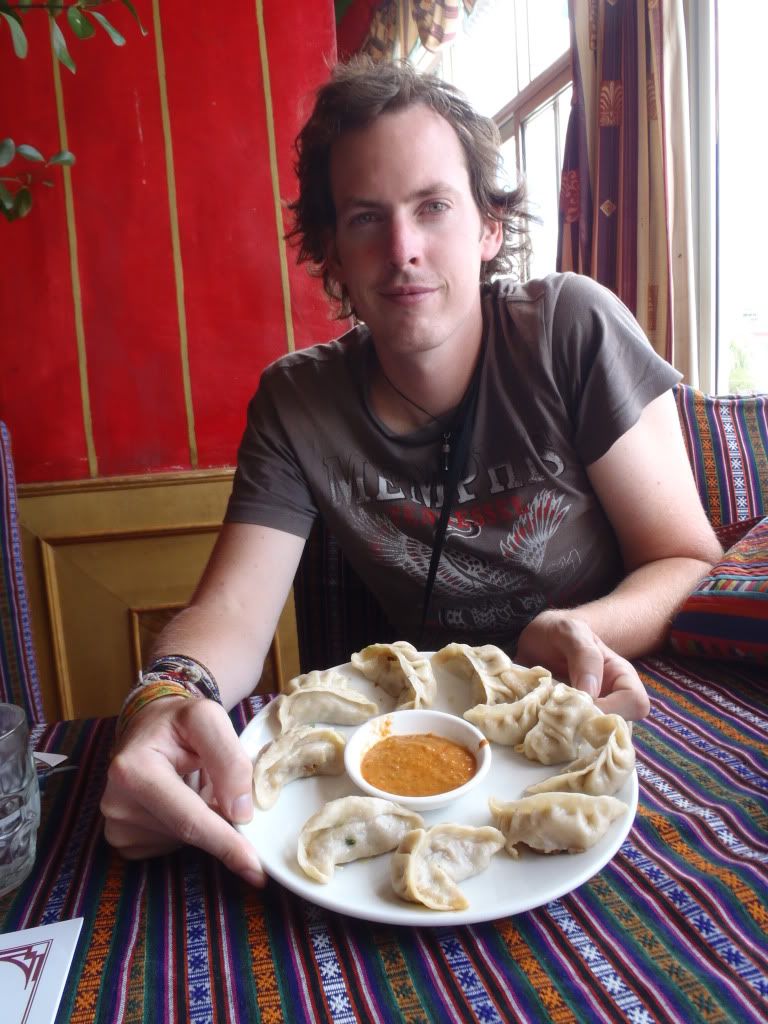
August 10th, 2010 was the starting date of the Shoton Festival in Lhasa! This festival is held at Drepung Monastery where monks unfold a gigantic ‘thangka’ or silk embroidered/painted image of the Buddha for worship by all. This image was so huge that even when we were still really far from the temple, we could see it clearly on the cliff wall. I later learned that thangkas are constructed with a grid, making them very geometric. Everything is done precisely according to guidelines with little room for artistic interpretation, understandably, as one is simply re-creating a divine representation. These thangka ‘scroll-images’ are actually quite practical, as they can be rolled up in case of rain and can be easily stored or transported. In the nomadic land of Tibet this is very important.
Taken from a Chinese-Tibetan website on the subject:
“The festival is for eating yoghurt. The reason of the connection between Shoton and yogurt has a long history. There are more than 300 pieces of regulations in Tibetan religious tenets and the most important is to avoid killing lives. In summer, all the animals come out for food and it is easy to kill those small worms , so during the period from 15th in June to 30th in July, the Lamas are ordered to do nothing but stay in their monastery for penance, which is called "Yale" in Tibetan language . However, staying inside the monastery for the whole day means no enough food for these lamas and it is said that the livestock of the family offering yogurt to lamas will be free of disease and can never get lost, nor were eaten by wild animals. With these known by more and more people, offering yogurt to lamas becomes a common activity on Shoton festival.”
Anyways, it was a really long climb (almost 2 hours of hiking!) up to the monastery as the traffic police banned any cars from driving in. Doing such a stressful hike on a day after we arrived in Tibet (when we were still not acclimatized yet) wasn’t the best idea, and I started to feel faint after a while. After stopping a few times to rest, our guide decided we should go the much easier, anti-clockwise direction around, so I would be able to make it to the top. Unfortunately, this isn’t the correct way to walk around a Buddhist-temple; in fact it’s actually a bit sacrilegious/offensive since it is the way the pre-Buddhist animist religion of ‘Bon’ walks around their temples. But our guide thought it would be best so we followed his lead (hoping Buddha doesn’t mind too much!) walking around the monastery and eventually arrived at the base of the giant thangka.
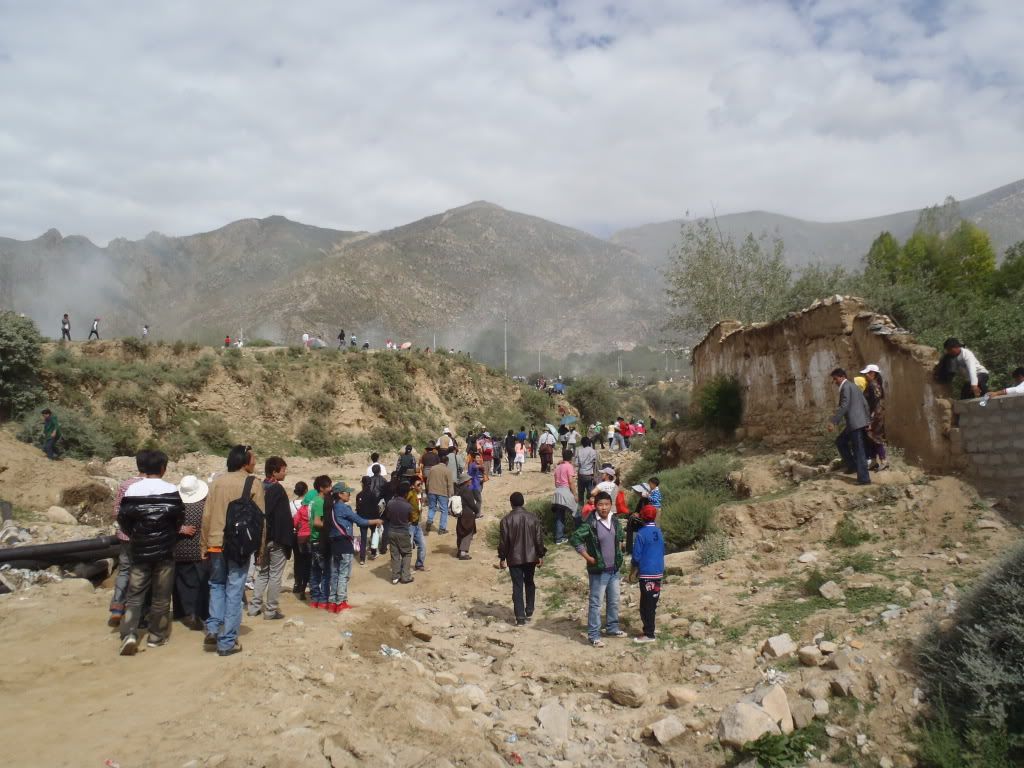

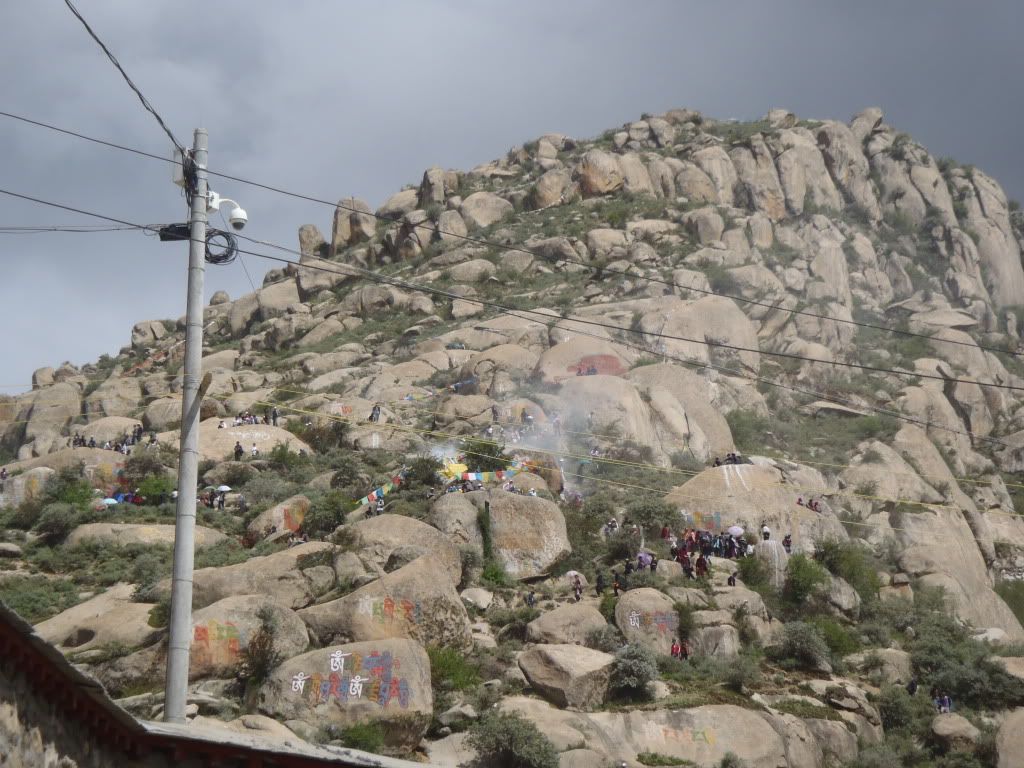
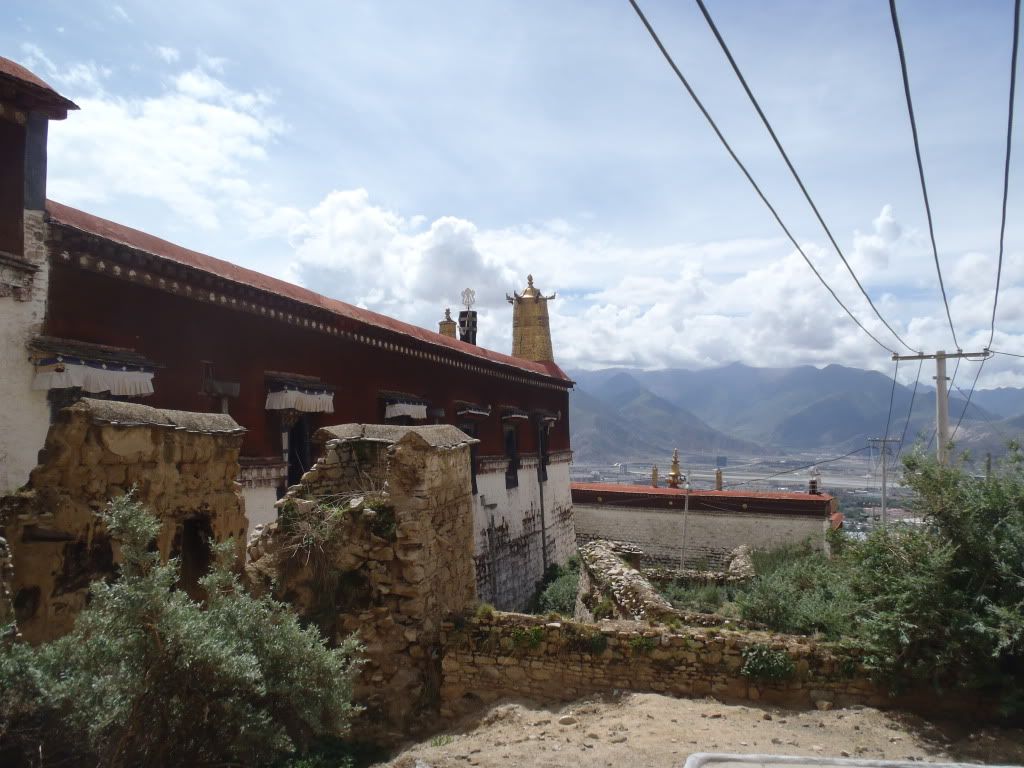
It was madness! Chinese police were everywhere to ‘keep the peace’ since the crowd was so large. There was also a little tent in front of the thangka which had monks chanting away inside, playing their special instruments of worship. Pilgrims were all trying to get as close as possible to the image. They were throwing their khatags (those white scarves) at the Buddha, throwing bits of paper confetti with prayers on them at the Buddha. We had bought some extra scarves as well, but ended up giving them to a monk below the Buddha image for a special blessing tap on the head. As quickly as people tossed their khatags at the image, monks standing there grabbed them back up and ‘bagged’ them (then I’m guessing they probably make their way back down the cliff to be resold to other pilgrims) in large sacks.

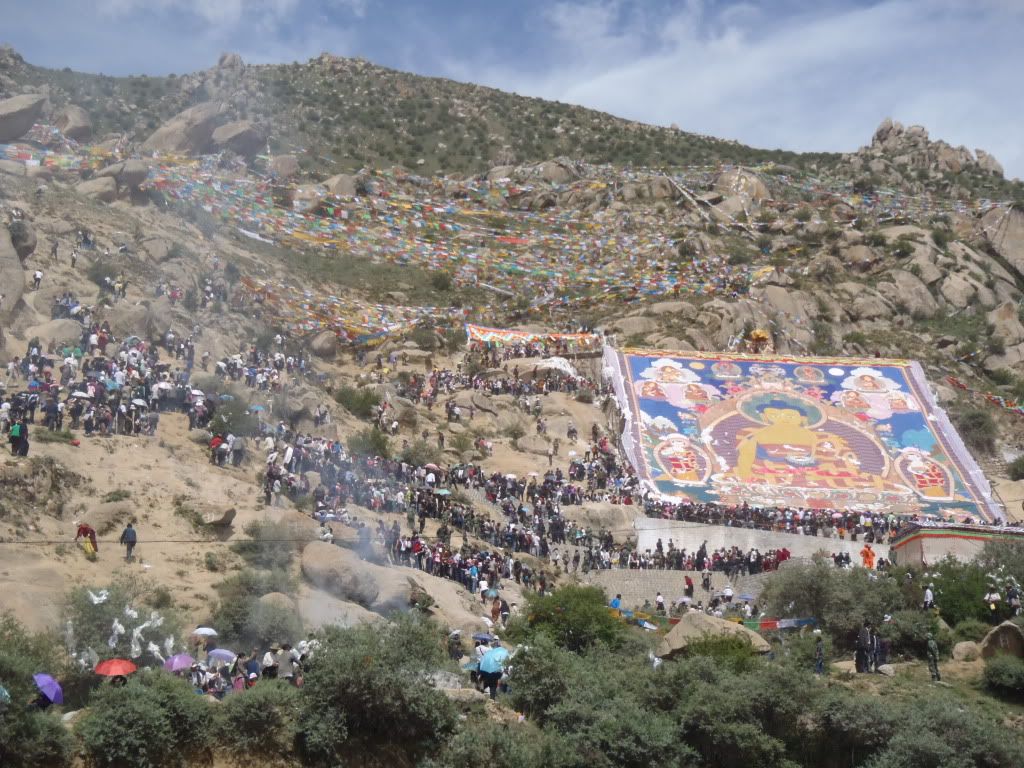
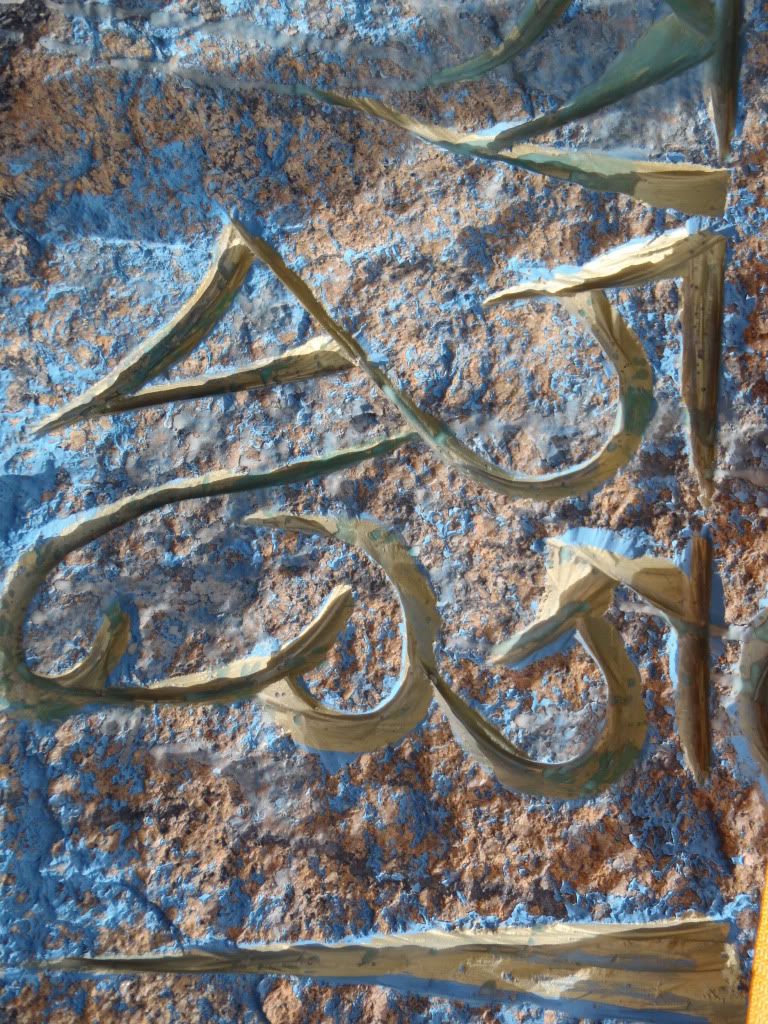
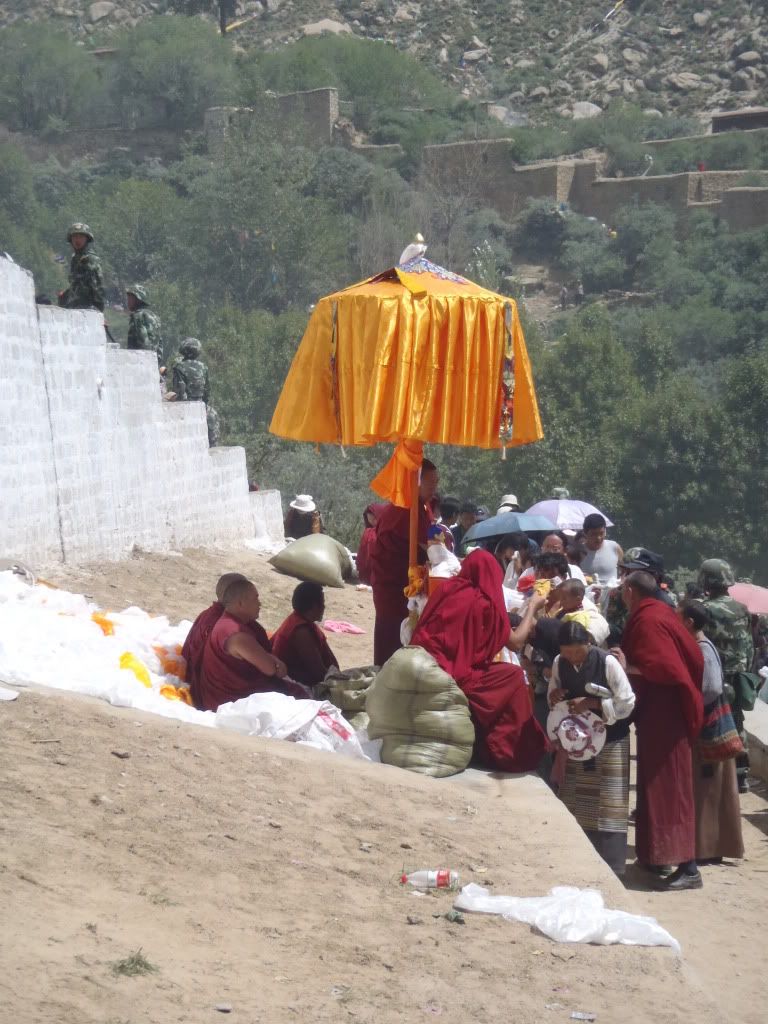
There was also a bit of a funny incident that occurred… Henk and I noticed that one of the monks was sweeping away bits of the paper ‘prayer confetti’ that started to cover the thangka. He swept them into a little pile at the bottom of the image, which happened to be right in front of a little boy. Bad idea. The young kid starting grabbing the confetti coming in and tossing it right back onto the thangka! Every time the monk gathered the pile, the kid had a new stockpile of confetti ammunition! Once the monk noticed this, and also saw that we were watching, he began to laugh at his situation. I’ll tell you another ‘laughing monk’ story here as well because I don’t remember which monastery it was at: We were walking up the stairs at one of the monasteries and there was a monk, a boy, and other pilgrims coming down the stairs. The monk started walking down first, not focusing on the boy behind him. The stairs were really steep and slippery, so the boy slipped before managing to catch himself. The clever monk quipped, ‘Look, a minute without my guidance, and he is already lost.’ Hehe!
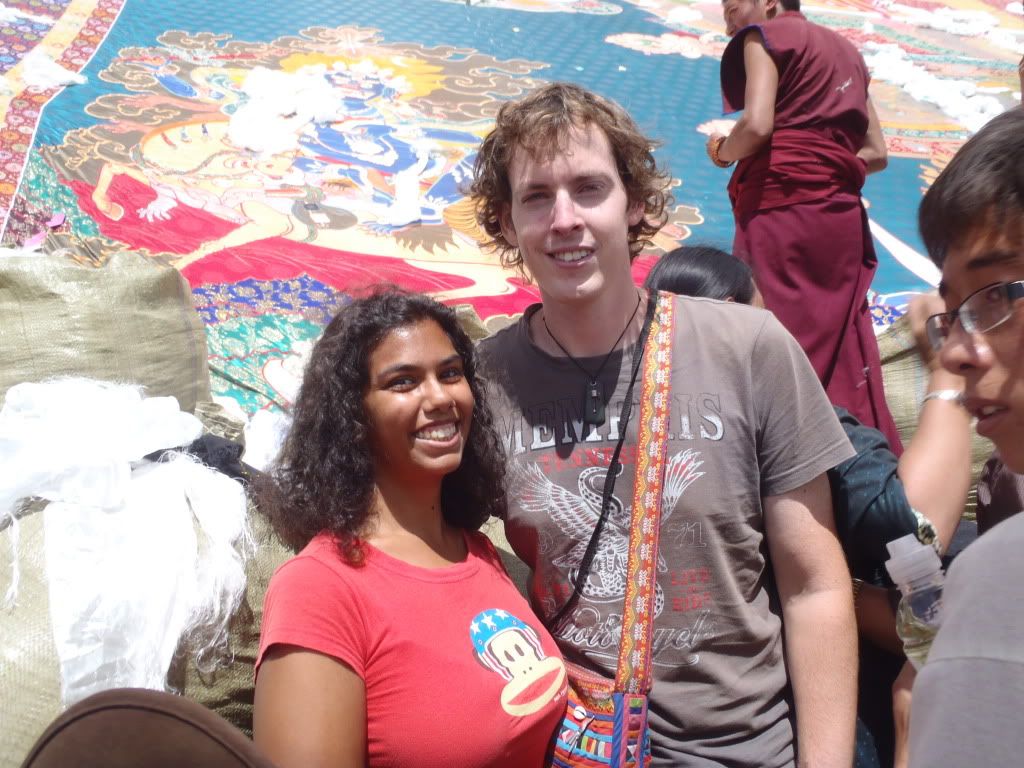
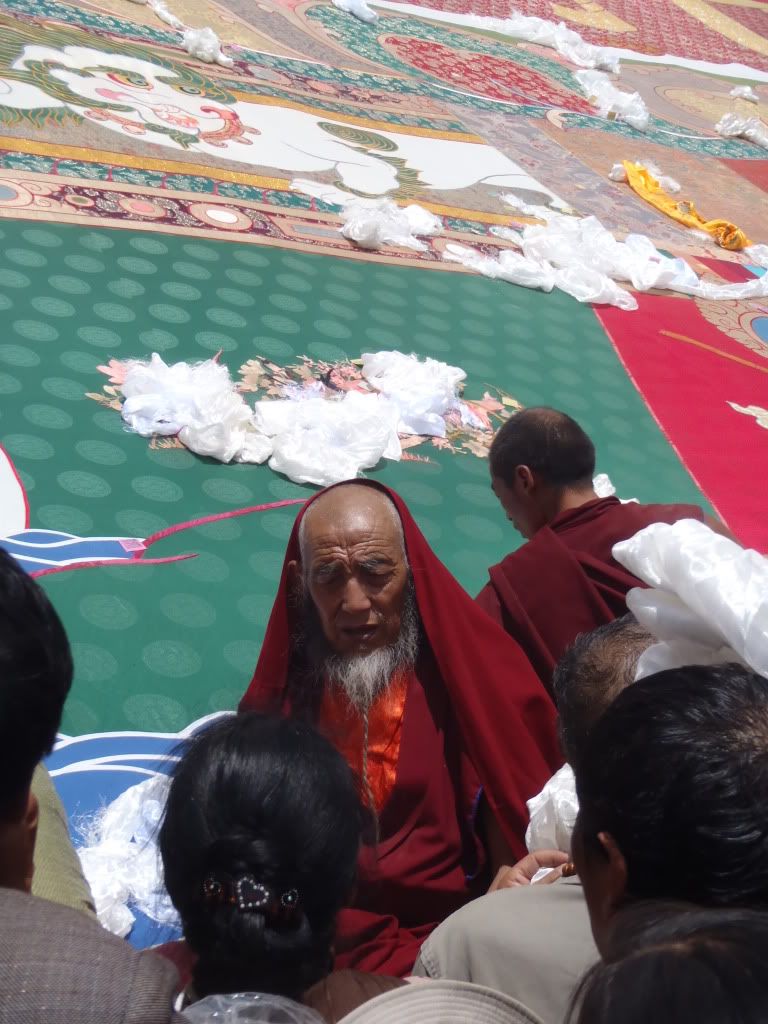
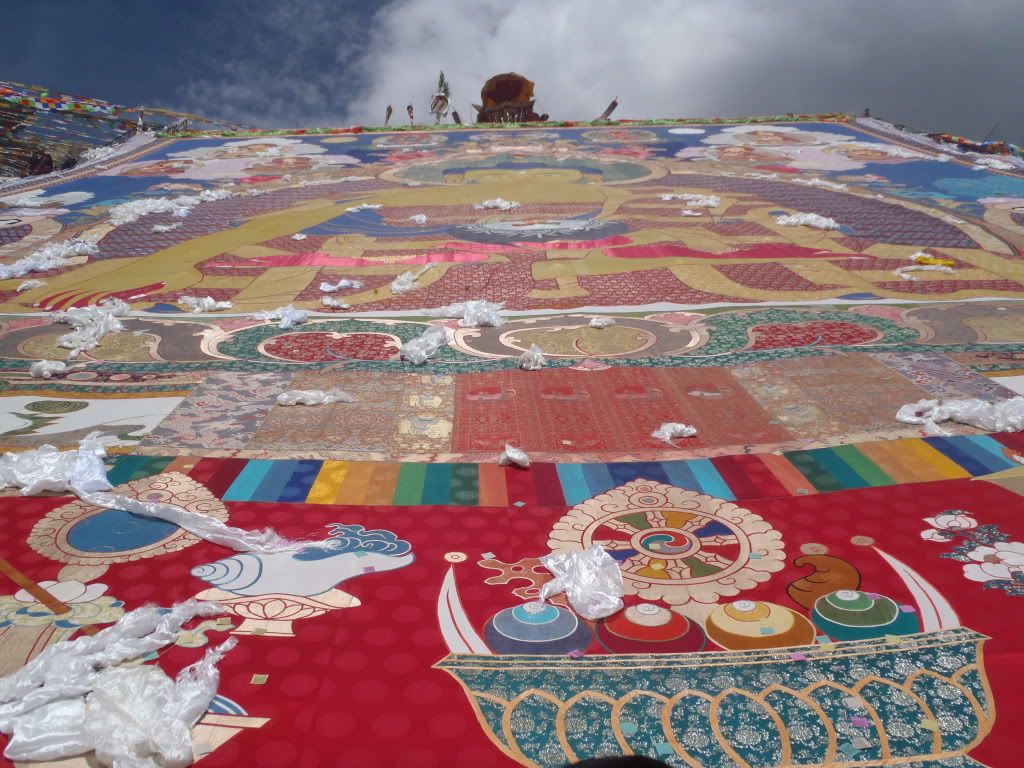

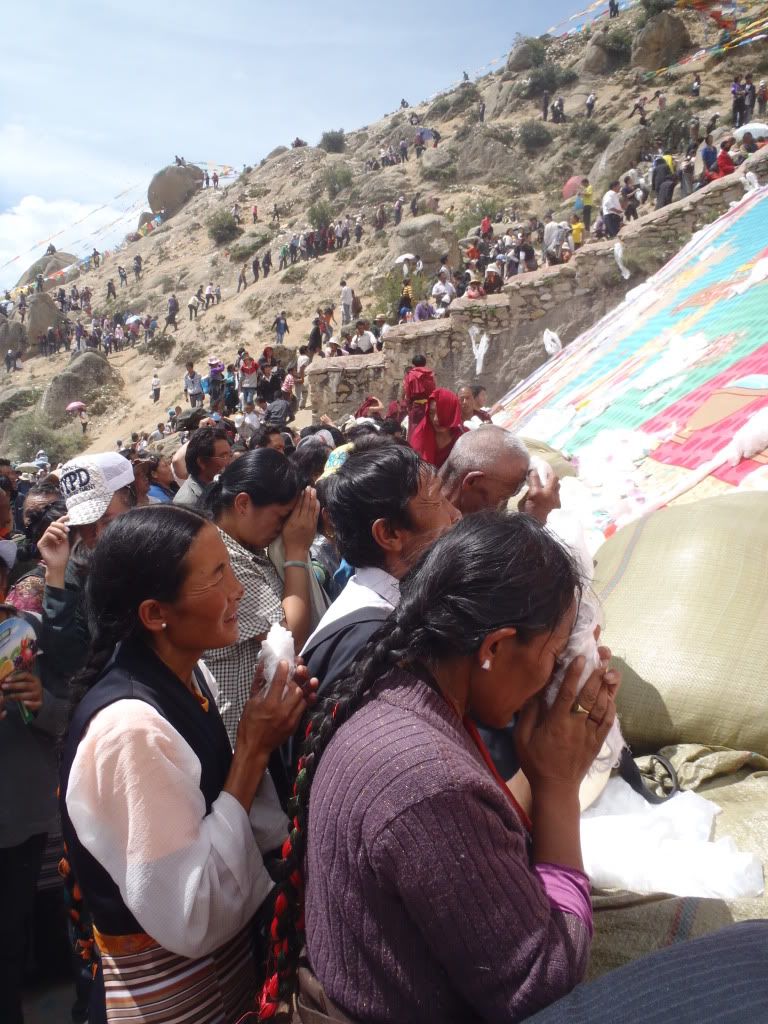


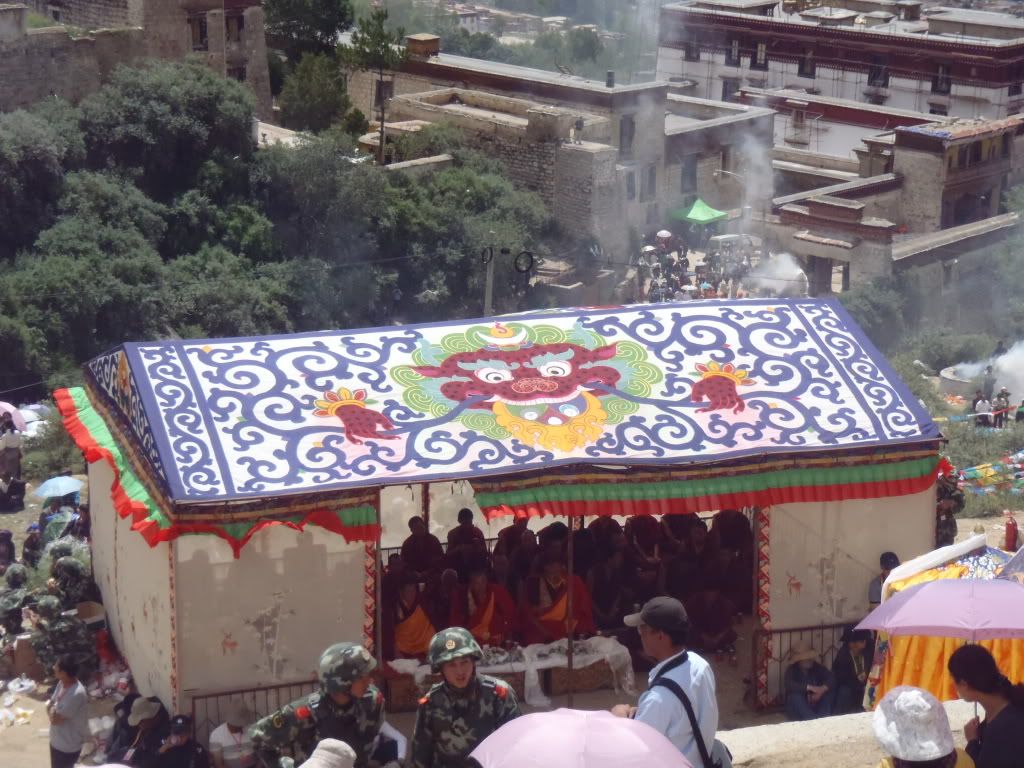
Once we finished our own Buddha-worship, we headed down the cliff while learning some more information about Buddhism from Ray -- we found out he had actually been a monk for 9 years of his life. Ray explained to us that Buddhism tells its followers to not blindly believe what they are told, but question everything until you’re sure you really understand and agree with the teaching. Even Buddhist teachers, question them because not all of them know what they are talking about. But then once you accept what the guru is saying, accept him as your teacher completely and trust him fully.
Here is a more in-depth explanation of what Ray told us, thanks to Wiki:
“Two characteristic aspects of Tibetan Buddhism are skepticism and devotion to the guru which have led it into conflict with Chinese socialism and so invited the destruction of the Tibetan intelligentsia under Mao. An attitude of critical skepticism is encouraged to promote abilities in analytic meditation. However, as in other Buddhist traditions, an attitude of reverence for the teacher is also highly prized.
In favor of skepticism towards Buddhist doctrines in general, Tibetans are fond of quoting sutra to the effect that one should test the Buddha's words as one would the quality of gold. On the other hand, at the beginning of a public teaching, a lama will do prostrations to the throne on which he will teach due to its symbolism, or to an image of the Buddha behind that throne, then students will do prostrations to the lama after he is seated. Merit accrues when one's interactions with the teacher are imbued with such reverence in the form of guru devotion, a code of practices governing them that derives from Indian sources. By such things as avoiding disturbance to the peace of mind of one's teacher, and wholeheartedly following his prescriptions, much merit accrues and this can significantly help improve one's practice.
There is a general sense in which any Tibetan Buddhist teacher is called a lama. A student may have taken teachings from many authorities and revere them all as lamas in this general sense. However, he will typically have one held in special esteem as his own root guru and is encouraged to view the other teachers who are less dear to him, however more exalted their status, as embodied in and subsumed by the root guru. Often the teacher the student sees as root guru is simply the one who first introduced him to Buddhism, but a student may also change his personal view of which particular teacher is his root guru any number of times.
The opposing principles of skepticism and guru devotion are reconciled with the Tibetan injunction to scrutinize a prospective guru thoroughly before finally adopting him as such without reservation. A Buddhist may study with a lama for decades before finally accepting him as his own guru.”
So refreshing for a belief system to TELL you to question it, rather than just blindly believe it! We continued our path, spotting a large pot near the side of the Drepung Monastery. When we asked about it we were told that there used to be a large number of monks living in the monasteries and since they can’t cook themselves, their food was made communally by the pilgrims in large cooking-pots. The Chinese have regulations now that determine the number of monks that are allowed to live at each of the monasteries (which has thus substantially decreased the number living there) however, so cooking-pots like this one aren’t in use anymore. As we got to the bottom of the hill, we spotted people doing some group dancing (which was over far too soon) and decided to try our first bit of yak cheese (which was dry, extremely hard, and completely disgusting.) (Henk thought it didn't taste that bad; the amount of chewing necessary to get some flavor out of the lump simply wasn't worth the effort.) Since it was so crowded we took a more public means of transportation back (foreigners aren’t allowed to take public transportation in Tibet for fear they’ll talk to the locals about their political situation) because there wasn’t a single taxi in sight.
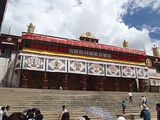
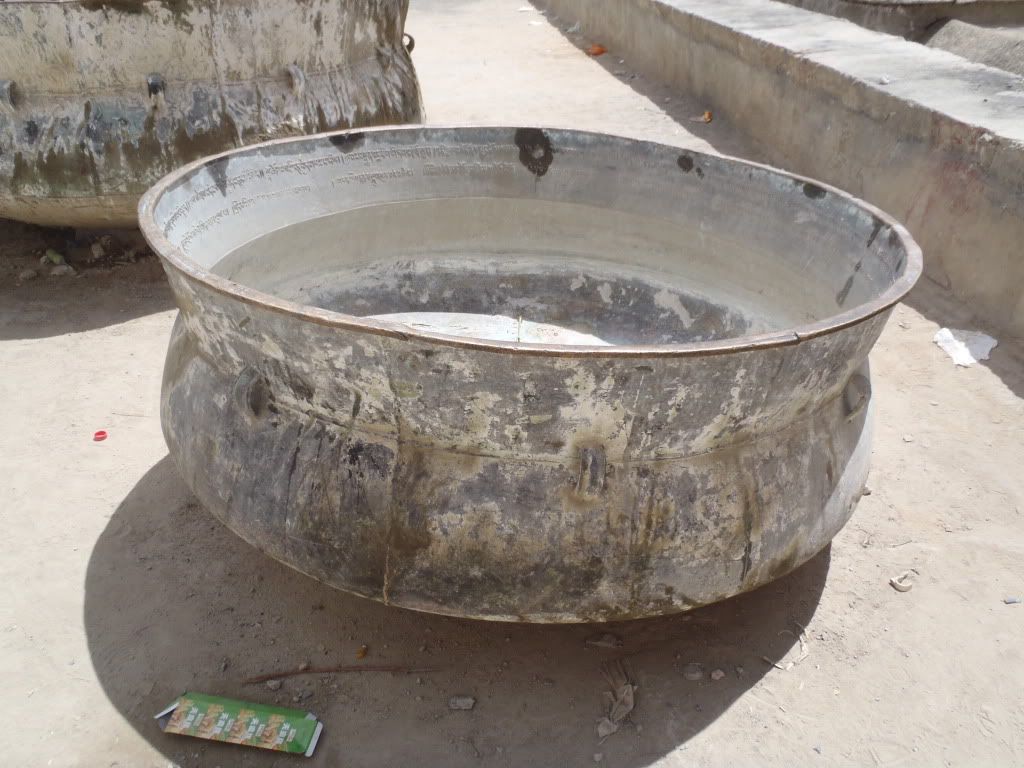
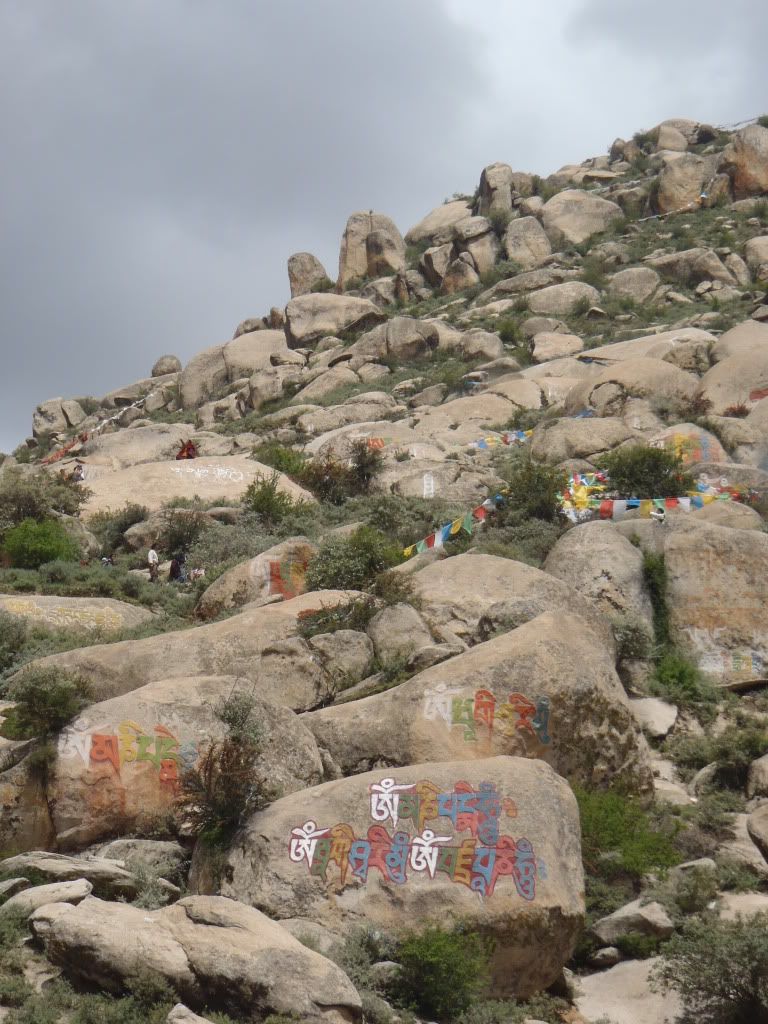
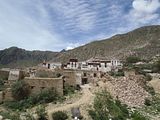

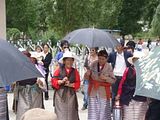
Once we were back in Lhasa we headed straight to New Mandala again to try their infamous yak burger, thought to be the best in town. It was indeed quite delicious! Plus this put us on a roll for trying Tibetan dishes. We also ordered some yak BBQ, but that was not nearly as impressive… not sure why, maybe they used lower quality yak-meat for it? We didn’t finish our lunch until around 4:00 PM so this meant that dinner would be a long way off. Ray dropped us back off at our hotel and we didn’t go out again (really, we had to rest or the AMS!) until dinner later around 10:00 PM. This was an extremely tasty butter chicken and naan for me and a thugkpa (Tibetan noodle soup dish) for Henk from Snowlands. The food was nice, but I’m sad to say I ended up feeling really sick that night! Don’t know if it was the altitude, the food, or a combination of both… but let’s just say not having a Western toilet available anywhere led to a painful evening. I even ended up throwing-up the remaining contents of my stomach – so I’m really not sure if I can recommend that butter chicken even though it tasted SO good. It’s a risk!
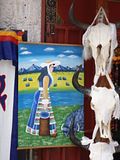

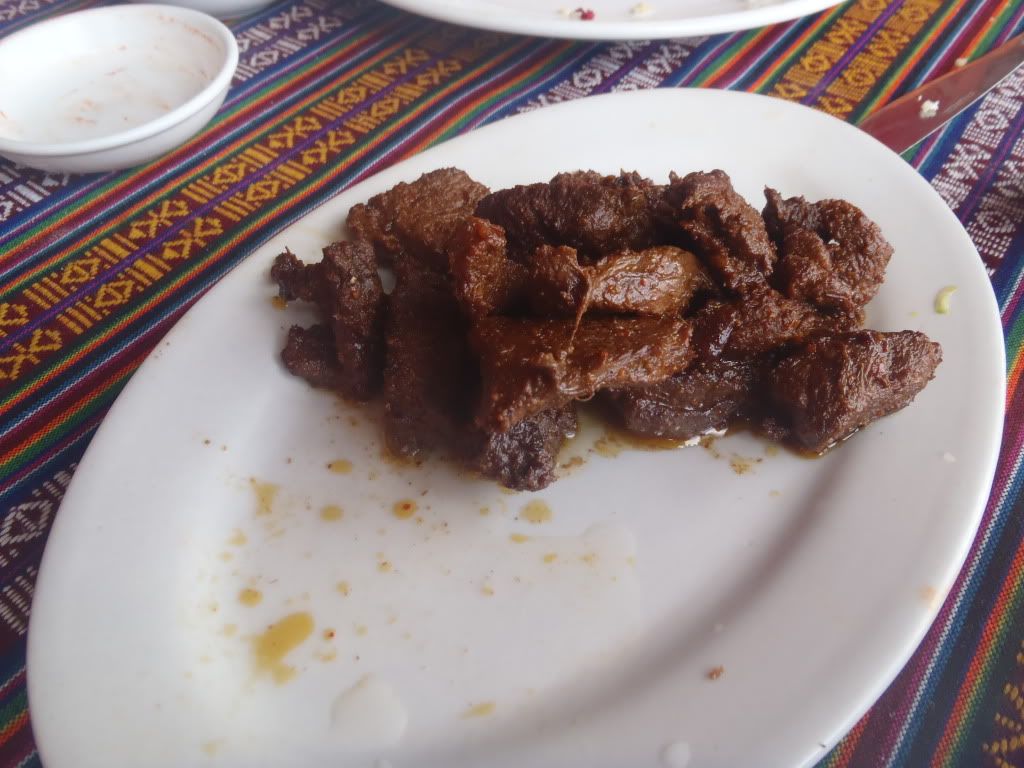
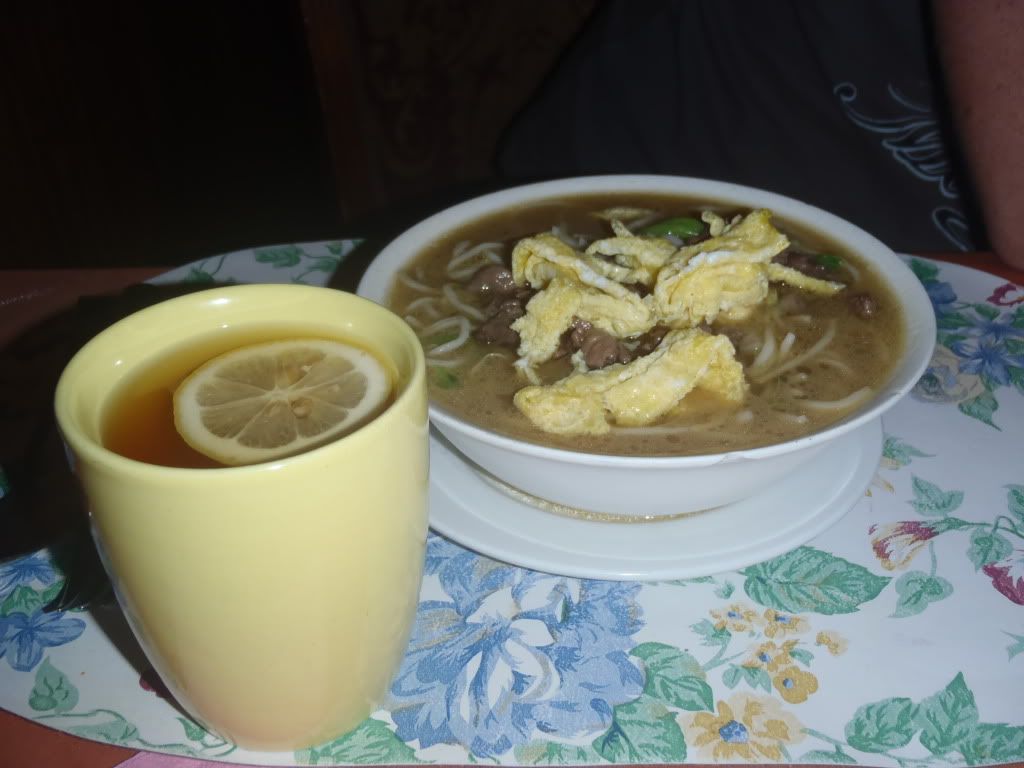
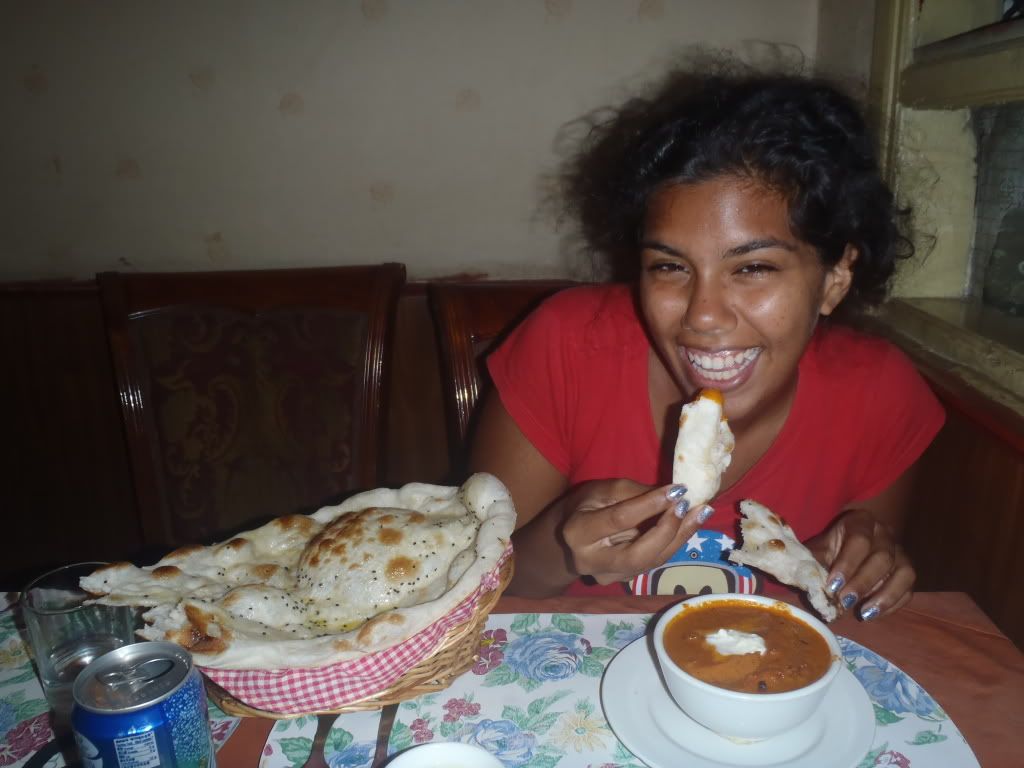
Henk will take over telling you about our next adventure starting on the 11th… which is another festival!
Francesca





Before we even got off the plane I noticed the change in oxygen levels – it was definitely a bit harder to breathe. Henk and I waited for our bags and then journeyed outside to meet our tour guide and driver for the next 2.5 weeks. Ray (Yes, that’s a code-name!) met us and immediately tossed a long, white scarf around each of our necks, then took our bags and led us to the car. These scarves, we later learned, are called ‘khatags’ and are used to designate a person (or a deity, image, etc.) of great importance which originated with the Tibetan tradition of adorning deities with clothing to show the god’s magnitude. We noticed later at the Shoton Festival that these scarves were being thrown at the giant Buddha image! (But more about that later.)
The drive to Lhasa, while a couple of hours long, was so scenic that we didn’t really notice the time! Vast open areas with water streaming through, bright blue sky as far as you could see in any direction. Plus that blue sky is an amazing contrast to the browner, barren-looking earth. There were fields filled with bound stacks of barley, which we’d later learn is the staple crop of the Tibetan people. We passed huge mountains with ladders drawn on in what looked like white chalk. Those ladders are drawn there by religious pilgrims who believe the area is sacred and wish to express this by making sure the god(s) has a way to get down from the heaven to earth should they need to make a visit. Henk and I also questioned our guide about the animal skulls we kept seeing mounted on top of doorway entrances. He explained to us that these were YAK bones! We were really excited to catch our first glimpse of a yak, though it wouldn’t be that day.

Upon arriving in Lhasa we immediately noticed a few key things about the city – many signs were written in both Tibetan and Chinese, but in some places, the signs were only written in Chinese. It was explained that Chinese is the language taught to Tibetans in school (while Tibetan is always spoken at home) and thus Tibetan was being replaced as the ‘masses’ language’ by Chinese. This is being perpetuated by the huge immigration of Han Chinese into Tibet. They have been described as absolutely ‘pouring-in’ post the infamous train to Tibet being completed. In fact, I later read that in the city of Lhasa, Han Chinese outnumber Tibetans with a ratio of 2:1.
The Chinese are given mass incentives by their government to move into the Tibet Autonomous Region (TAR), as the government believes the immigration will ‘aid in the ‘assimilation’ of Tibetan people. Chinese thus are ever-present in Lhasa as the owners of the majority of companies, guesthouses, restaurants, tour agencies, and even souvenir stalls lining the streets. While all workers seen on the construction sites of roads and temples, those cleaning hotels or working as waitresses/waiters, and even those guiding Westerners around Tibet are indeed Tibetans, their bosses are almost always Han Chinese. Likewise, Chinese police are absolutely everywhere. They sit on top of roofs with their rifles posed and their binoculars scanning the city, they march in the streets in unison, and they are even working undercover in monasteries (which have been the main arena of protest against China’s presence in Tibet) or other areas as spies.

Putting aside the Han Chinese and focusing on the Tibetans themselves, the first thing we noticed about the Tibetan people once we stepped foot into Lhasa is how different and decent-looking they are! Not only were they much more attractive than most of the other people we encountered on our trip (and surely much better looking than the Han Chinese) but they were also dressed extremely sharp. All of them had a bit of permanent rosy-cheek, I guess from living in such a dry climate so close to the sun. Strangely enough, it was actually a little like permanent make-up and gave them a unique-look that wasn’t half-bad, even helped to draw more attention to their eyes.
The men wore crisp-looking jackets and cowboy-esque hats; the women all had their hair neatly braided with colorful strings pinned up and wrapped around their heads and donned long striped skirts. Some of the Tibetan men, known as Khampas, had fake pieces of black string, made to look like hair, attached to their own with a stylish clip. Even those who didn’t look very traditional, the children and some of the younger adults, wore snazzy-looking fake but sharp-looking designer jeans, jackets, and caps. And every outfit was finished off with large amounts of fake coral, turquoise, or Buddha’s eye jewelry. Wow, who would have ever predicted that Tibet would actually look fashion-forward!
A little explanation from the Wiki about the origin of Tibetan people:
Tibetans traditionally explain their own origins as rooted in the marriage of the monkey Pha Trelgen Changchup Sempa and rock ogress Ma Drag Sinmo.[18] Tibetans who display compassion, moderation, intelligence, and wisdom are said to take after their fathers, while Tibetans who are "red-faced, fond of sinful pursuits, and very stubborn" are said to take after their mothers.
Ray had found us a hostel in Lhasa that was in our price-range and thankfully turned out to be pretty decent. It was called the Rama Kharpo (the White Goat) and accordingly had a large painted image of a goat behind its front desk. We learned that it was an ancient belief that the area where the Jokhang Temple is located now in Lhasa originally had a lake on it and goats were used to help fill the area with sand and construct the temple. Since they worked hard on this, they have a bit of a special place in Tibetan’s hearts, which is how our guesthouse got its name honoring them! Since our room wasn’t quite ready yet, we dropped off our bags and took a walk through the city.

What we saw was really breath-taking: there were pilgrims everywhere displaying their religious dedication. Full-body prostration was done not only at the walls of the temples, but even just in the middle of the street! Worshippers had special wooden blocks they used to protect their hands when they did what basically looked like a ‘Slip ‘N’ Slide’ onto the hard pavement ended up with their bellies to the floor. Then they would get up and repeated the process… as many times as they could muster! The more times you repeat something (saying a mantra, spinning a prayer-wheel, prostrating yourself before the divine) in Tibet, the more effective the result will be.


We arrived at New Mandala Restaurant ready to partake in some Tibetan food: yak momos! These little delicious things were balls of yak meat wrapped up in a ‘dumpling-like’ casing. They came with a slightly spicy dipping sauce to dip the suckers in. Shockingly (despite the insanely slow service at the restaurant) yak was quite tasty!! It was surprisingly juicy and flavorful for such a healthy, lean animal. Unlike cattle, the fat in yak doesn’t ‘marble’ inside the meat but ends up as a separate layer one can just ‘pull-off’ of the animal when butchering. This results in yak being 90+ % fat free, but apparently it also doesn’t affect the taste of the animal! We chatted with Ray about some of his recent guiding experiences while consuming our first Tibetan dish. Once we returned, our room was ready and we were ready to crash. But not sleep! While the altitude was getting to us, Ray warned us to not sleep now, otherwise we won’t be able to later. (He also gave us more things we couldn’t do yet because of the risk of AMS – take a shower, have any yak-butter tea, etc.) Henk and I tried to rest up watching some Chinese movies (I think ‘Raise the Red Lantern’ and later Henk ventured out to an Indian place ‘Lhasa Namaste’ to bring us back (sadly) some less-than-average Indian food. Didn’t matter… the next morning we had a festival to attend!

August 10th, 2010 was the starting date of the Shoton Festival in Lhasa! This festival is held at Drepung Monastery where monks unfold a gigantic ‘thangka’ or silk embroidered/painted image of the Buddha for worship by all. This image was so huge that even when we were still really far from the temple, we could see it clearly on the cliff wall. I later learned that thangkas are constructed with a grid, making them very geometric. Everything is done precisely according to guidelines with little room for artistic interpretation, understandably, as one is simply re-creating a divine representation. These thangka ‘scroll-images’ are actually quite practical, as they can be rolled up in case of rain and can be easily stored or transported. In the nomadic land of Tibet this is very important.
Taken from a Chinese-Tibetan website on the subject:
“The festival is for eating yoghurt. The reason of the connection between Shoton and yogurt has a long history. There are more than 300 pieces of regulations in Tibetan religious tenets and the most important is to avoid killing lives. In summer, all the animals come out for food and it is easy to kill those small worms , so during the period from 15th in June to 30th in July, the Lamas are ordered to do nothing but stay in their monastery for penance, which is called "Yale" in Tibetan language . However, staying inside the monastery for the whole day means no enough food for these lamas and it is said that the livestock of the family offering yogurt to lamas will be free of disease and can never get lost, nor were eaten by wild animals. With these known by more and more people, offering yogurt to lamas becomes a common activity on Shoton festival.”
Anyways, it was a really long climb (almost 2 hours of hiking!) up to the monastery as the traffic police banned any cars from driving in. Doing such a stressful hike on a day after we arrived in Tibet (when we were still not acclimatized yet) wasn’t the best idea, and I started to feel faint after a while. After stopping a few times to rest, our guide decided we should go the much easier, anti-clockwise direction around, so I would be able to make it to the top. Unfortunately, this isn’t the correct way to walk around a Buddhist-temple; in fact it’s actually a bit sacrilegious/offensive since it is the way the pre-Buddhist animist religion of ‘Bon’ walks around their temples. But our guide thought it would be best so we followed his lead (hoping Buddha doesn’t mind too much!) walking around the monastery and eventually arrived at the base of the giant thangka.




It was madness! Chinese police were everywhere to ‘keep the peace’ since the crowd was so large. There was also a little tent in front of the thangka which had monks chanting away inside, playing their special instruments of worship. Pilgrims were all trying to get as close as possible to the image. They were throwing their khatags (those white scarves) at the Buddha, throwing bits of paper confetti with prayers on them at the Buddha. We had bought some extra scarves as well, but ended up giving them to a monk below the Buddha image for a special blessing tap on the head. As quickly as people tossed their khatags at the image, monks standing there grabbed them back up and ‘bagged’ them (then I’m guessing they probably make their way back down the cliff to be resold to other pilgrims) in large sacks.




There was also a bit of a funny incident that occurred… Henk and I noticed that one of the monks was sweeping away bits of the paper ‘prayer confetti’ that started to cover the thangka. He swept them into a little pile at the bottom of the image, which happened to be right in front of a little boy. Bad idea. The young kid starting grabbing the confetti coming in and tossing it right back onto the thangka! Every time the monk gathered the pile, the kid had a new stockpile of confetti ammunition! Once the monk noticed this, and also saw that we were watching, he began to laugh at his situation. I’ll tell you another ‘laughing monk’ story here as well because I don’t remember which monastery it was at: We were walking up the stairs at one of the monasteries and there was a monk, a boy, and other pilgrims coming down the stairs. The monk started walking down first, not focusing on the boy behind him. The stairs were really steep and slippery, so the boy slipped before managing to catch himself. The clever monk quipped, ‘Look, a minute without my guidance, and he is already lost.’ Hehe!








Once we finished our own Buddha-worship, we headed down the cliff while learning some more information about Buddhism from Ray -- we found out he had actually been a monk for 9 years of his life. Ray explained to us that Buddhism tells its followers to not blindly believe what they are told, but question everything until you’re sure you really understand and agree with the teaching. Even Buddhist teachers, question them because not all of them know what they are talking about. But then once you accept what the guru is saying, accept him as your teacher completely and trust him fully.
Here is a more in-depth explanation of what Ray told us, thanks to Wiki:
“Two characteristic aspects of Tibetan Buddhism are skepticism and devotion to the guru which have led it into conflict with Chinese socialism and so invited the destruction of the Tibetan intelligentsia under Mao. An attitude of critical skepticism is encouraged to promote abilities in analytic meditation. However, as in other Buddhist traditions, an attitude of reverence for the teacher is also highly prized.
In favor of skepticism towards Buddhist doctrines in general, Tibetans are fond of quoting sutra to the effect that one should test the Buddha's words as one would the quality of gold. On the other hand, at the beginning of a public teaching, a lama will do prostrations to the throne on which he will teach due to its symbolism, or to an image of the Buddha behind that throne, then students will do prostrations to the lama after he is seated. Merit accrues when one's interactions with the teacher are imbued with such reverence in the form of guru devotion, a code of practices governing them that derives from Indian sources. By such things as avoiding disturbance to the peace of mind of one's teacher, and wholeheartedly following his prescriptions, much merit accrues and this can significantly help improve one's practice.
There is a general sense in which any Tibetan Buddhist teacher is called a lama. A student may have taken teachings from many authorities and revere them all as lamas in this general sense. However, he will typically have one held in special esteem as his own root guru and is encouraged to view the other teachers who are less dear to him, however more exalted their status, as embodied in and subsumed by the root guru. Often the teacher the student sees as root guru is simply the one who first introduced him to Buddhism, but a student may also change his personal view of which particular teacher is his root guru any number of times.
The opposing principles of skepticism and guru devotion are reconciled with the Tibetan injunction to scrutinize a prospective guru thoroughly before finally adopting him as such without reservation. A Buddhist may study with a lama for decades before finally accepting him as his own guru.”
So refreshing for a belief system to TELL you to question it, rather than just blindly believe it! We continued our path, spotting a large pot near the side of the Drepung Monastery. When we asked about it we were told that there used to be a large number of monks living in the monasteries and since they can’t cook themselves, their food was made communally by the pilgrims in large cooking-pots. The Chinese have regulations now that determine the number of monks that are allowed to live at each of the monasteries (which has thus substantially decreased the number living there) however, so cooking-pots like this one aren’t in use anymore. As we got to the bottom of the hill, we spotted people doing some group dancing (which was over far too soon) and decided to try our first bit of yak cheese (which was dry, extremely hard, and completely disgusting.) (Henk thought it didn't taste that bad; the amount of chewing necessary to get some flavor out of the lump simply wasn't worth the effort.) Since it was so crowded we took a more public means of transportation back (foreigners aren’t allowed to take public transportation in Tibet for fear they’ll talk to the locals about their political situation) because there wasn’t a single taxi in sight.






Once we were back in Lhasa we headed straight to New Mandala again to try their infamous yak burger, thought to be the best in town. It was indeed quite delicious! Plus this put us on a roll for trying Tibetan dishes. We also ordered some yak BBQ, but that was not nearly as impressive… not sure why, maybe they used lower quality yak-meat for it? We didn’t finish our lunch until around 4:00 PM so this meant that dinner would be a long way off. Ray dropped us back off at our hotel and we didn’t go out again (really, we had to rest or the AMS!) until dinner later around 10:00 PM. This was an extremely tasty butter chicken and naan for me and a thugkpa (Tibetan noodle soup dish) for Henk from Snowlands. The food was nice, but I’m sad to say I ended up feeling really sick that night! Don’t know if it was the altitude, the food, or a combination of both… but let’s just say not having a Western toilet available anywhere led to a painful evening. I even ended up throwing-up the remaining contents of my stomach – so I’m really not sure if I can recommend that butter chicken even though it tasted SO good. It’s a risk!





Henk will take over telling you about our next adventure starting on the 11th… which is another festival!
Francesca

0 Comments:
Post a Comment
<< Home